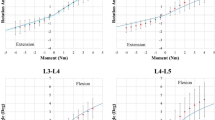Abstract
The aim of this study was to compare the following three main fixation techniques: pedicle screw (PS) technique, lateral mass screw (LS) technique, and transarticular screw (TS) technique. A detailed, geometrically accurate, nonlinear C3–C7 FE model had been successfully developed and validated. Then three finite element (FE) models were reconstructed by different fixation techniques following C4–C6 level laminectomy. A compressive preload of 74 N combined with a pure moment of 1.8 Nm in flexion, extension, left–right lateral bending, and left–right axial rotation was applied to the models. The results showed that maximum von Mises stress on the fixation devices was much higher in the FE models of TS technique, compared with the models of PS and LS techniques. Furthermore, the screws inserted by TS technique had high stress concentration at the middle part of the screws. Screw inserted by PS and LS techniques had high stress concentration at the actual cap–rod–screw interface. The highest level of maximal stress was obtained with the fixation device of the TS technique. TS technique induces noticeable differences in the stress compared to the posterior cervical fixation technique, regarding the higher stress level on fixation devices.







Similar content being viewed by others
References
Epstein NE (2003) Laminectomy for cervical myelopathy. Spinal Cord 41:317–327
Pal PP, Cooper HH (1988) The vertical stability of the cervical spine. Spine 13:447–449
Houten JK, Cooper PR (2003) Laminectomy and posterior cervical plating for multilevel cervical spondylotic myelopathy and ossification of the posterior longitudinal ligament: effects on cervical alignment, spinal cord compression, and neurological outcome. Neurosurgery 52:1081–1087
Mikawa Y, Shikata J, Yamamuro T (1987) Spinal deformity and instability after multilevel cervical laminectomy. Spine 12:6–11
ElSaghir H, Böhm H (2000) Anterior versus posterior plating in cervical corpectomy. Arch Orthop Trauma Surg 120:549–554
Schultz KD Jr, McLaughlin MR, Haid RW Jr, Comey CH, Rodts GE Jr, Alexander J (2000) Single-stage anterior-posterior decompression and stabilization for complex cervical spine disorders. J Neurosurg 93:214
Kwon BK, Vaccaro AR, Grauer JN, Beiner JM (2007) The use of rigid internal fixation in the surgical management of cervical spondylosis. Neurosurgery 60:S118–S129
Ludwig SC, Kramer DL, Balderston RA, Vaccaro AR, Foley KF, Albert TJ (2000) Placement of pedicle screws in the human cadaveric cervical spine: comparative accuracy of three techniques. Spine 25:1655–1667
Takayasu M, Hara M, Yamauchi K, Yoshida M, Yoshida J (2003) Transarticular screw fixation in the middle and lower cervical spine. Technical note. J Neurosurg Spine 99:132–136
Xu R, Zhao L, Chai B, Ma W, Xia H, Wang G, Jiang W (2009) Lateral radiological evaluation of transarticular screw placement in the lower cervical spine. Eur Spine J 18:392–397
DalCanto RA, Lieberman I, Inceoglu S, Kayanja M, Ferrara L (2005) Biomechanical comparison of transarticular facet screws to lateral mass plates in two-level instrumentations of the cervical spine. Spine 30:897–902
Jones EL, Heller JG, Silcox DH, Hutton WC (1997) Cervical pedicle screws versus lateral mass screws: anatomic feasibility and biomechanical comparison. Spine 22:977–982
Wheeldon JA, Pintar FA, Knowles S, Yoganadan N (2006) Experimental flexion/extension data corridors for validation of finite element models of young, normal cervical spine. J Biomech 39:375–380
Hussain M, Natarajan RN, Fayyazi AH, Braaksma BR, Andersson GB, An HS (2009) Screw angulation affects bone-screw stresses and bone graft load sharing in anterior cervical corpectomy fusion with a rigid screw-plate construct: a finite element model study. Spine J 12:1016–1023
Keaveny, Tony M, Buckley, Jenni M (2006) Biomechanics of vertebral bone. In: Spine technology handbook. Elsevier, Amsterdam, pp 63–98
Kumaresan S, Yoganandan N, Pintar FA (1999) Finite element analysis of the cervical spine: a material property sensitivity study. Clin Biomech 14:41–53
Yoganandan N, Kumaresan S, Pintar FA (2000) Geometric and mechanical properties of human cervical spine ligaments. J Biomech Eng 122:623–629
Goel VK, Clausen JD (1998) Prediction of load sharing among spinal components of a C5–C6 motion segment using the finite element approach. Spine 23:684–691
Clausen JD, Goel VK, Traynelis VC, Scifert J (1997) Uncinate processes and Luschka joints influence the biomechanics of the cervical spine: quantification using a finite element model of the C5–C6 segment. J Orthop Res 15:342–347
Yoganandan N, Kumaresan SC, Voo L, Pintar FA, Larson SJ (1996) Finite element modeling of the C4–C6 cervical spine unit. Med Eng Phys 18:569–574
Yoganandan N, Kumaresan S, Pintar FA (2001) Biomechanics of the cervical spine. Part 2. Cervical spine soft tissue responses and biomechanical modeling. Clin Biomech 16:1–27
Moroney SP, Schultz AB, Miller JA, Andersson GB (1988) Load-displacement properties of lower cervical spine motion segments. J Biomech 21:769–779
Pelker RR, Duranceau JS, Panjabi MM (1991) Cervical spine stabilization: a three dimensional, biomechanical evaluation of rotational stability, strength, and failure mechanisms. Spine 16:117–122
Panjabi MM, Crisco JJ, Vasavada A, Oda T, Cholewicki J, Nibu K, Shin E (2001) Mechanical properties of the human cervical spine as shown by three-dimensional load-displacement curves. Spine 26:2692–2700
Finn MA, Brodke DS, Daubs M, Patel A, Bachus KN (2009) Local and global subaxial cervical spine biomechanics after single-level fusion or cervical arthroplasty. Eur Spine J 18:1520–1527
Hong-Wan N, Ee-Chon T, Qing-Hang Z (2004) Biomechanical effects of C2–C7 intersegmental stability due to laminectomy with unilateral and bilateral facetectomy. Spine 29:1737–1745
Kotani Y, Cunningham BW, Abumi K, McAfee PC (1994) Biomechanical analysis of cervical stabilization systems: an assessment of transpedicular screw fixation in the cervical spine. Spine 19:2529–2539
Miyamoto H, Sumi M, Uno K (2009) Utility of modified transarticular screw in the middle and lower cervical spine as intermediate fixation in posterior long fusion surgery. J Neurosurg Spine 11:555–561
Author information
Authors and Affiliations
Corresponding author
Rights and permissions
About this article
Cite this article
Duan, Y., Zhang, H., Min, Sx. et al. Posterior cervical fixation following laminectomy: a stress analysis of three techniques. Eur Spine J 20, 1552–1559 (2011). https://doi.org/10.1007/s00586-011-1711-z
Received:
Revised:
Accepted:
Published:
Issue Date:
DOI: https://doi.org/10.1007/s00586-011-1711-z




